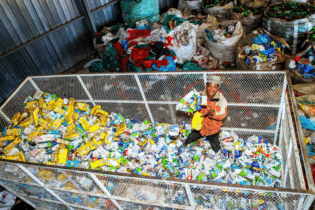
Plastics SA Cape Town Cycle Tour clean up crew at work
For the 11th consecutive year, Plastics SA’s Sustainability Manager, John Kieser, will be coordinating clean-up crews who will be working around the clock to keep the routes and surrounding areas used for the 40th Cape Town Cycle Tour (Sunday, 11 March 2018) and the 49th Old Mutual Two Oceans Marathon (Saturday, 31 March 2018) clean and litter-free.
This year more than 200 cleaners, who have been employed from various townships in and around Cape Town, will once again demonstrate what can be achieved through unity, teamwork and collaboration when they take to the streets and pick up all the water and energy drink sachets used by the athletes or litter left behind by the spectators.
Recycling and up-cycling
The majority of the waste collected during these events is plastic waste, which has a high recycling value. Several truckloads of plastic waste are collected and recycled annually at these events. Food waste is sent to Noordhoek for composting, whilst all non-organic event waste collected during the OMTOM are recycled and up-cycled into unique school desks for under-resourced schools as part of the event’s #GoGreen campaign.
“Over the years, the active and visible involvement of our clean-up team and the PETCO branded bins and truck at these events have helped to create an awareness of the plastics industry’s dedication to keeping plastic litter out of the environment,” Kieser says.
Committed to waste management
He adds that the City of Cape Town plays a major role in boosting their clean-up efforts by ensuring that the routes for these annual events are cleaned prior to the race days.
“The plastics industry is proud to work alongside the organisers who are committed to waste management and recycling and are doing everything in their power to ensure these iconic events take place with as little impact as possible on the municipal water supply and the environment,” Kieser concludes.








